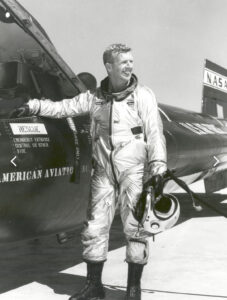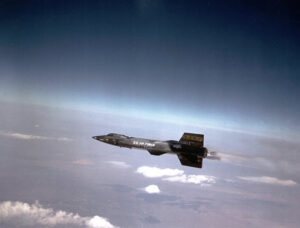
 The first official space flight occurred on April 12, 1961, when Soviet astronaut Yuri Alekseyevich Gagarin, a Soviet pilot and cosmonaut who, aboard the first successful crewed spaceflight, became the first human to journey into outer space. Traveling on Vostok 1, Gagarin completed one orbit of Earth on 12 April 1961. While that was the first official manned space flight, there were other times that man touched space.
The first official space flight occurred on April 12, 1961, when Soviet astronaut Yuri Alekseyevich Gagarin, a Soviet pilot and cosmonaut who, aboard the first successful crewed spaceflight, became the first human to journey into outer space. Traveling on Vostok 1, Gagarin completed one orbit of Earth on 12 April 1961. While that was the first official manned space flight, there were other times that man touched space.
The North American X-15 was an experimental US single seat rocket powered airplane that was taken aloft by a B-52 bomber acting as its “mother ship” and released to test extremely high speed and extremely high-altitude flight. The first such flight took place on June 8, 1959.
The hypersonic rocket-powered aircraft known as the North American X-15, was operated by the United States Air Force and the National Aeronautics and Space Administration as part of the X-plane series of experimental aircraft. While it didn’t exactly go into space, the X-15 set speed and altitude records in the 1960s, reaching the edge of outer space and returning with valuable data used in aircraft and spacecraft design, making it a precursor to the spacecraft of today. The X-15’s highest speed, 4,520 miles per hour , was achieved on October 3, 1967, when William J Knight flew at Mach 6.7 at an altitude of 102,100 feet or 19.34 miles. This set the official world record for the highest speed ever recorded by a crewed, powered aircraft, and it remains unbroken to this day.
While pilot, William Knight flew an all-time record speed of Mach 6.7 (4520 miles per hour), the fastest speed flown by a powered and manned piloted aircraft, in 1967, his flight wasn’t the first record setting flight in the X-15. This incredible speed was not even close to the maximum potential of the X-15. A typical commercial passenger jet flies at a speed of about 460 – 575 miles per hour, when cruising at about 36,000 feet, which figures to about 75-85% of the speed of sound. I can’t imagine going any faster than that, much less wrap my head around more than 4520 miles per hour!!
In 1963, pilot Joe Walker flew his X-15 into the history books by flying it to a record altitude of 67 miles and achieving a speed of almost Mach 5 (3794 miles per hour). While there is no sharp physical boundary that marks the end of atmosphere and the beginning of space, it is generally marked at the Karman line, and for purposes of space flight defined as an altitude of 60 miles, although some place the line at 50 miles above Earth’s mean sea level.
The X-15 program continued until 1968, when the rocket planes were retired. On notable pilot was Neil Armstrong, who was also the first man to walk on the Moon, of course. Armstrong made 7 flights in the speedy rocket plane. Also interesting to note is the fact that during the X-15 program, 12 pilots flew a combined 199 flights. Of the 12 pilots, 8 
 pilots flew a combined 13 flights that exceeded the altitude of 50 miles, thus qualifying these pilots as being astronauts!! Of those 13 flights, two (flown by the same civilian pilot) met the FAI (Féderátion Aéronautique Internationale) definition of 62 miles of outer space. The 5 Air Force pilots qualified for military astronaut wings immediately, while the 3 civilian pilots were eventually awarded NASA astronaut wings in 2005, 35 years after the last X-15 flight.
pilots flew a combined 13 flights that exceeded the altitude of 50 miles, thus qualifying these pilots as being astronauts!! Of those 13 flights, two (flown by the same civilian pilot) met the FAI (Féderátion Aéronautique Internationale) definition of 62 miles of outer space. The 5 Air Force pilots qualified for military astronaut wings immediately, while the 3 civilian pilots were eventually awarded NASA astronaut wings in 2005, 35 years after the last X-15 flight.


Leave a Reply